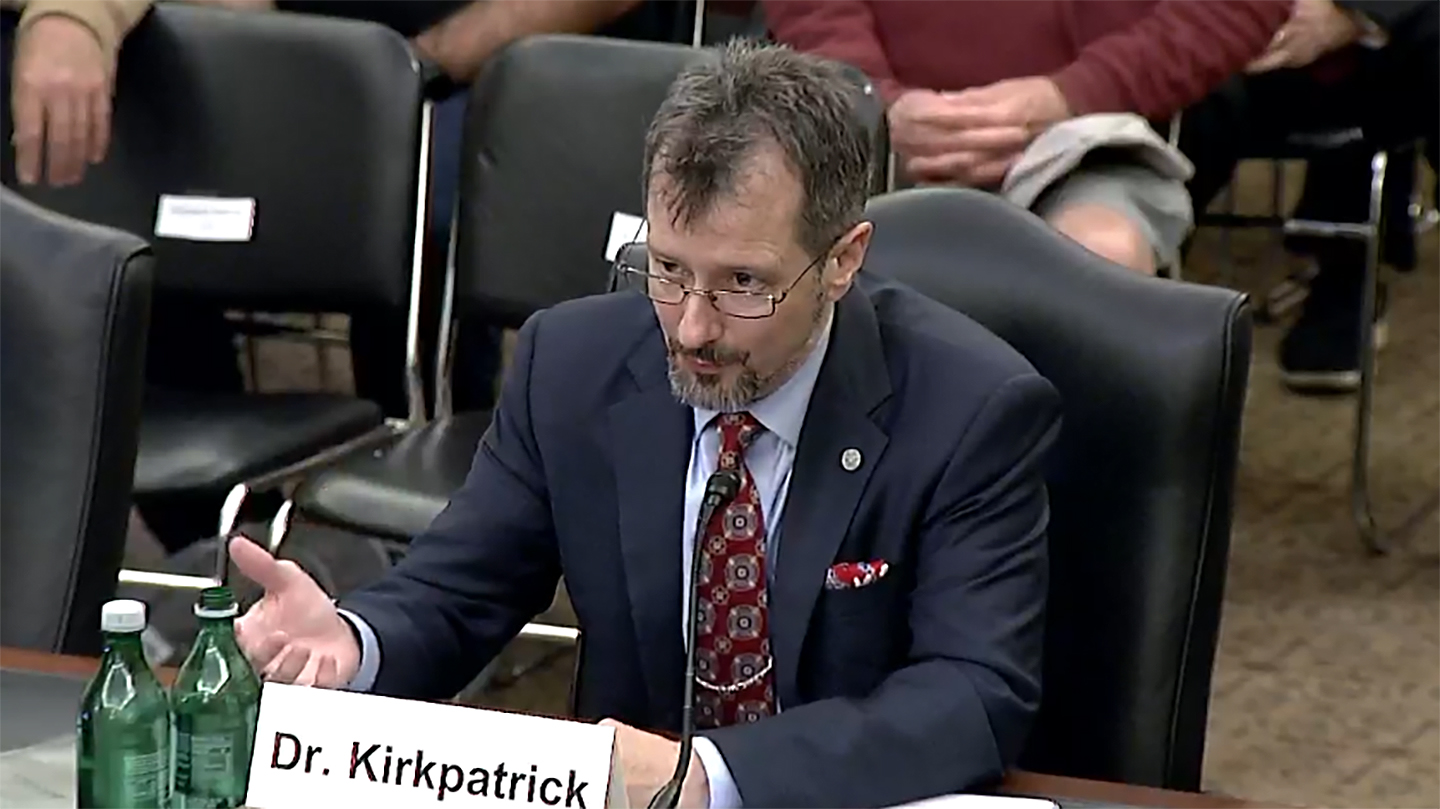There is no “credible evidence” that unidentified objects – observed largely by U.S. military pilots – are examples of extraterrestrial technology or have unexplainable abilities, the Pentagon’s UFO Czar told a Senate hearing on Wednesday. But there are “concerning indicators,” he said, that some of these sightings could be of Chinese origin.
“I should also state clearly for the record,” said Sean M. Kirkpatrick, director of the Pentagon’s All-domain Anomaly Resolution Office (AARO), “that in our research, AARO has found no credible evidence thus far of extraterrestrial activity, off-world technology or objects that defy the known laws of physics.”

Referring to the Pentagon-speak phrase of “unidentified aerial phenomena (UAP)” now being used to replace the term UFO in the public lexicon, Kirkpatrick added that “if the significant scientific data were ever attained that a UAP encounter can only be explained by extraterrestrial origin, we are committed to working with our interagency partners at NASA to appropriately inform U.S. government leadership of its findings.”
So what could these objects be? February’s incidents of U.S. fighter jets shooting down four high-flying aerial objects in American and Canadian airspace – including one identified as a Chinese government surveillance balloon – were top of mind during the open portion of Wednesday’s Senate Armed Services Committee Subcommittee on Emerging Threats and Capabilities hearing.
Committee Vice Chair Sen. Joni Ernst (R-Iowa) asked Kirkpatrick if there are “any Chinese or Russia technical advancements to surveil or attack U.S. interests.”
“Part of what we have to do as we go through these – especially the ones that show signatures of advanced technical capabilities – is determine if there is a foreign nexus,” Kirkpatrick testified. “That’s really hard if what we observe doesn’t have a Chinese or Russian flag on the side of it.”
However, “of the cases that are showing you some sort of enhanced technical signature – of which we’re talking single percentages of the entire population of cases we have – I am concerned about what that nexus is, and I have indicators that some are related to foreign capabilities. We have to investigate that with our IC (intelligence community) partners. And as we get evidence to support that, that gets then handed off to the appropriate IC agency to investigate.”
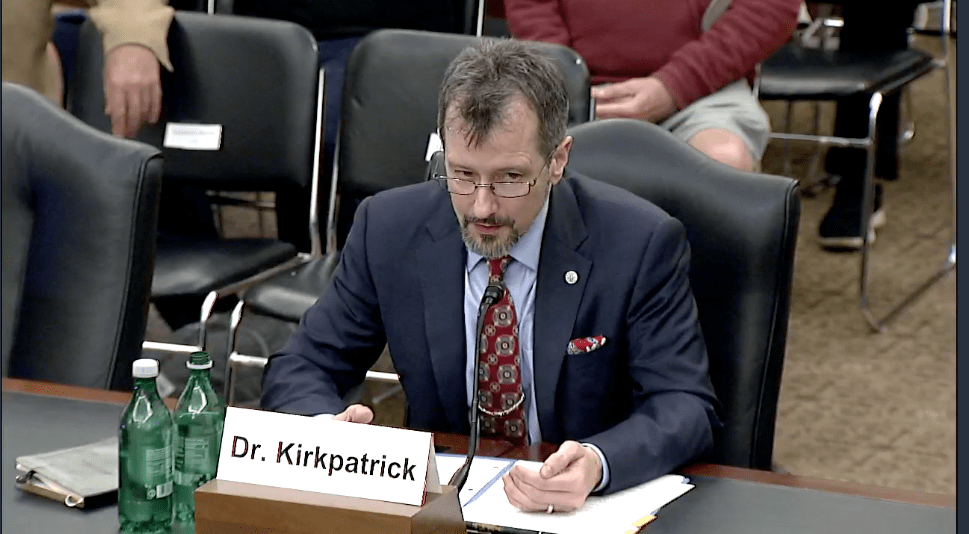
Ernst further pushed Kirkpatrick on the issue, asking him “if Chinese or Russian advanced technologies could be causing some of these anomalous behaviors.”
Kirkpatrick did not rule that out, saying that Beijing especially has been quicker to attempt tech breakthroughs than the U.S.
The Chinese in particular “are less risk averse at technical advancement than we are. They are just willing to try things and see if it works. Are there capabilities that could be employed against us in both an ISR [intelligence, surveillance, reconnaissance] and weapons fashion? Absolutely. Do I have evidence that they’re doing it in these cases? No, but I have concerning indicators.”
He did not elaborate.
While Kirkpatrick had no evidence that Chinese or Russian technology accounts for some of these sightings, The War Zone has spent the past several years suggesting that many of these observations are actually foreign adversaries harnessing advances in lower-end unmanned aerial vehicle technology, and even simpler platforms, to gather intelligence of extreme fidelity on some of America’s most sensitive warfighting capabilities. You can read more about that in our deep dive here.
The shootdown of the Chinese balloon in particular is the most recent manifestation of that capability.

And even AARO’s own numbers indicate that balloons or balloon-like objects make up the bulk of these sightings.
In January, the Office of the Director of National Intelligence (ODNI) issued a 12-page report saying that AARO was investigating 510 incidents and that its “initial analysis and characterization” of 366 newly-identified reports showed that more than half exhibited “unremarkable characteristics.”
Of those, 26 were characterized as Unmanned Aircraft Systems (UAS) or UAS-like entities; 163 were characterized as balloon or balloon-like entities; and six were attributed to “clutter,” which ODNI identifies as “birds, weather events, or airborne debris like plastic bags.”
Kirkpatrick on Wednesday told senators that AARO is now investigating about 650 sightings, of which about half are of “anomalous, interesting value.”
AARO’s next quarterly report “will be coming out here pretty soon,” he said. The next annual report will be released in June or July. There are about 20 to 30 new UAP sighting reports that are “about halfway through that analytic process” while “a handful” have been completed, with several case closure reports done.
Kirkpatrick also shared AARO data collected about the most common characteristics of the UAPs sighted.
“What you’ll notice is that there is a heavy what we call collection bias both in altitude and in geographic location,” he said. “That’s where all of our sensors exist. That’s where our training ranges are. That’s where our operational ranges are. That’s where all of our platforms are.”
UAPs, he said, are “mostly round, mostly one to four meters, white, silver, translucent metallic.” They are observed “at between 10,000 to 30,000 feet with apparent velocities from stationary to Mach 2 (about 1,535mph). No thermal exhausts [are] usually detected. We get intermittent radar returns. We get intermittent radio returns and we get their thermal signatures. That’s what we’re looking for. And trying to understand what that is.”
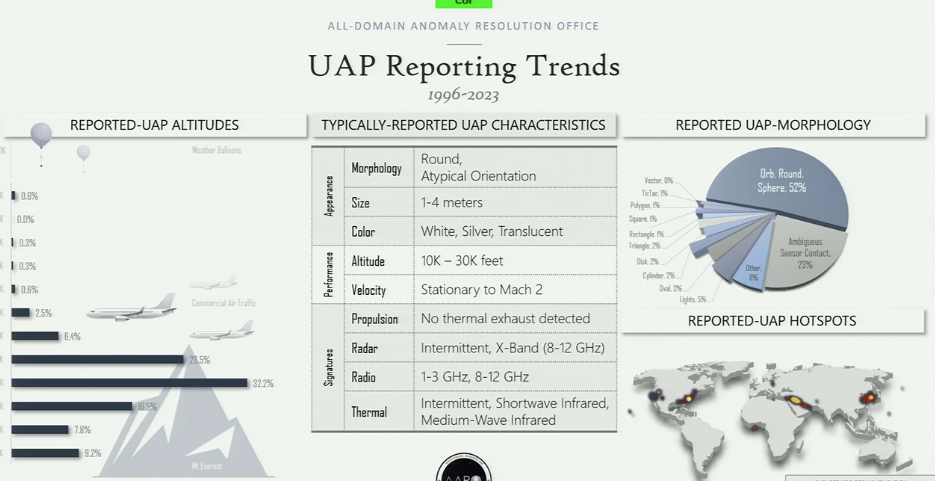
He also provided two case studies – one a still-unresolved incident in the Middle East and one in South Asia that turned out to be a commercial aircraft – to showcase the challenges of investigating these sightings.
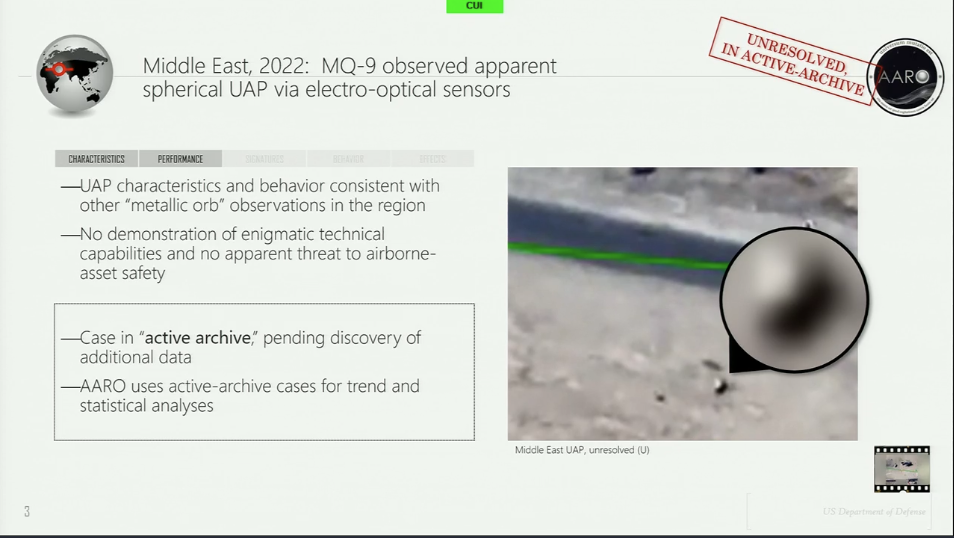
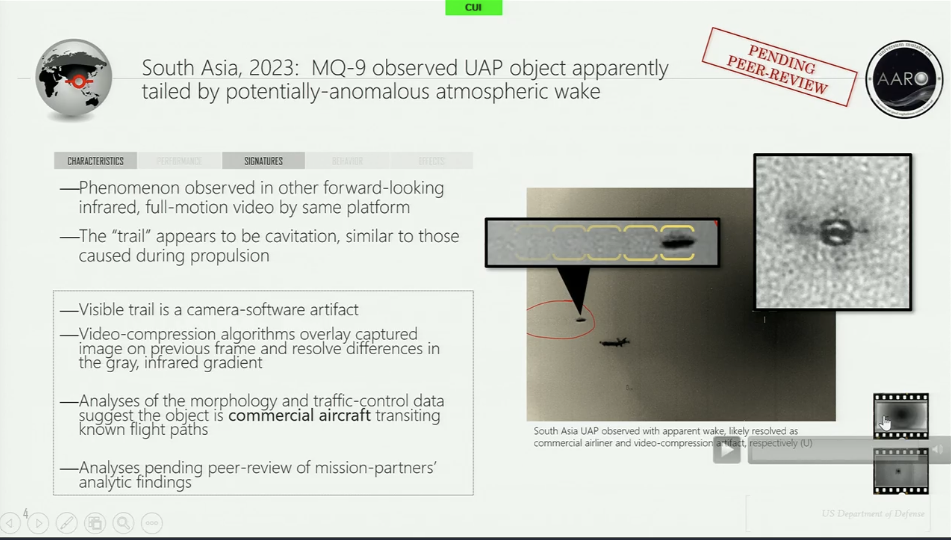
That work included time-consuming frame-by-frame analysis of videos taken by U.S. drones.
“This is the kind of data that we have to work with, the type of analysis that we have to do which can be quite extensive when you have to pull these apart, frame by frame,” Kirkpatrick testified. “Further, we’re now matching all of this with the models of all of those imaging sensors so that I can actually show how their sensors are going to respond. All of these sensors don’t necessarily respond the way you think they do. Especially out in the world and in the field.”
The issue of funding for AARO, as well as its role in investigating the balloon and other object sightings in February, was also addressed Wednesday. Concerns about AARO being left out of the loop during the balloon saga were something we raised in February, which you can read more about here.
“It took a letter to Secretary Austin from Senator [Marco] Rubio and me and 14 other senators to get the office temporary relief for the current fiscal year,” subcommittee chairwoman Kirsten Gillibrand (D-NY) said in her opening remarks.

“This year, I intend to probe a series of specific issues and the recent incidents where multiple objects were shot down over North America. It seems that Pentagon leadership did not turn to AARO’s office to play a leading role in advising the combatant commander. We need to know whether this will continue. We need to know whether the leadership at DOD will bring AARO into the decision-making processes and we need to know what role AARO will play in interagency coordination after the NSC Working Group disbands.”
Kirkpatrick explained that when “the objects were first detected I got a call from Joint Staff leadership to come in late one night to review events as they were unfolding and to give them an assessment based on what we knew at that time.”
He said he worked with the director of the Joint Staff, as well as the heads of its intelligence and operations directorates “that night and over a couple of following days on what are the types of things that we are tracking from an unidentified object perspective” and “what databases do we use” to track known objects.
Kirkpatrick said the senators should reach out to the White House “for the decision on how they did the response. We did not play a role…other than that initial advice on what we are seeing and how we are seeing.”
In addition to its existing classified web portal, AARO is also working on a public-facing portal for people to use to contact it about UAPs.
“So I would like to first say thank you all very much for referring the witnesses that you have thus far to us,” said Kirkpatrick. “I appreciate that. We’ve brought in nearly two dozen so far. It’s been very helpful. I’d ask that you continue to do that until we have an approved plan.”
The process, however, is still underway, he added.
“We have a multi-phase approach for doing that, that we’ve been socializing and have submitted for approval. Once that happens, then we should be able to push all that out and get this a little more automated. What I would ask though, is as you all continue to refer to us and refer witnesses to us, please try to prioritize the ones that you want to do because we do research staff dealing with that.”
And while Kirkpatrick on Wednesday downplayed any link between these objects and extraterrestrial technology, it’s not as if he is a complete UFO denier.
Last month, he and Abraham Loeb, head of the Galileo Project, Astronomy Department, Harvard University, co-authored a draft of a paper suggesting that “an artificial interstellar object could potentially be a parent craft that releases many small probes during its close passage to Earth, an operational construct not too dissimilar from NASA missions.”
They were inspired to write the paper by the 2017 appearance of a mysterious space object dubbed “Oumuamua.”
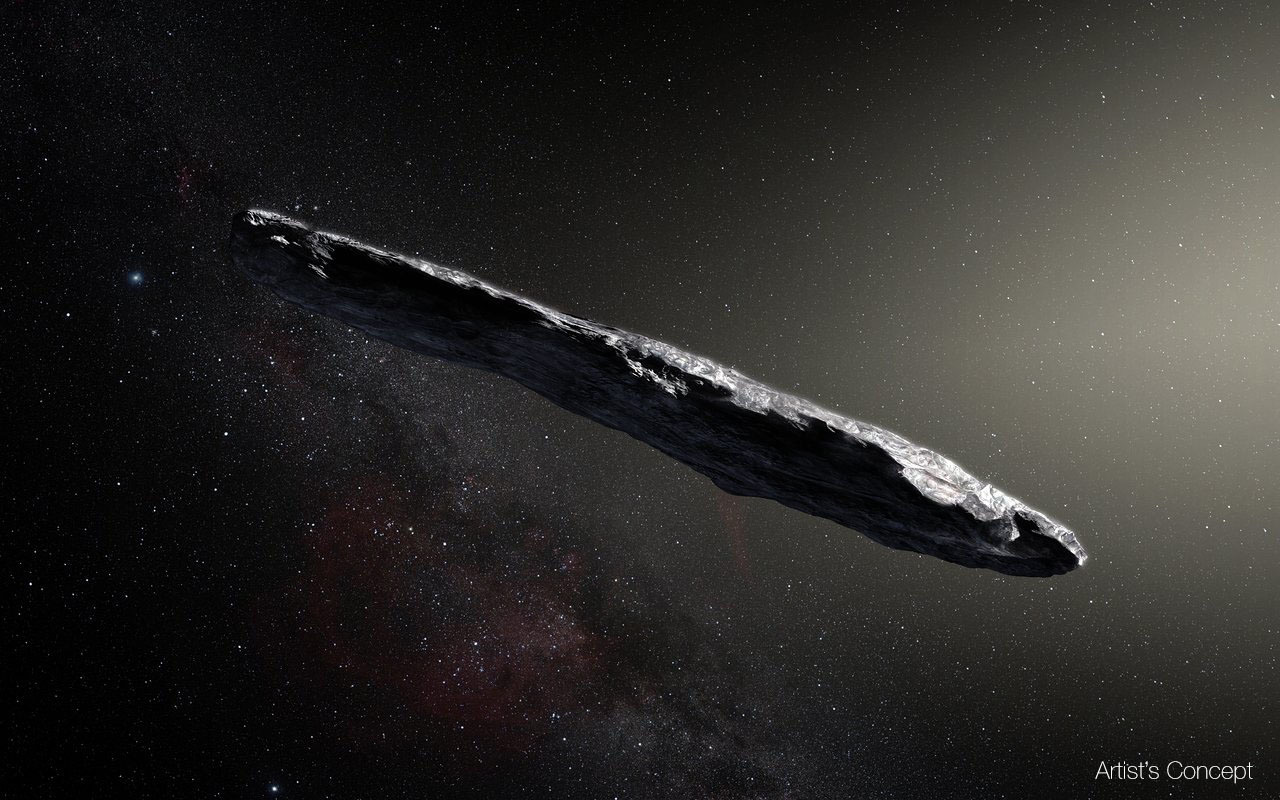
Earth in particular could be an attractive option for wayfaring aliens, they added.
“Within a close range to a star, extraterrestrial technological probes could use starlight to charge their batteries and liquid water as their fuel. This would explain why they would target the habitable region around stars, where liquid water may exist on the surface of rocky planets with an atmosphere, like the Earth. Habitable planets would be particularly appealing to trans-medium probes, capable of moving between space, air and water. From a large distance, Venus, Earth or Mars would be equally attractive for probes. But upon closer inspection, Earth would show spectral signatures of liquid water (through reflection of blue light) and vegetation (through its red edge) that might attract selective attention.”
Despite that, Kirkpatrick’s testimony today is likely to disappoint those who insist that these sightings are alien life forms or from another dimension. But it also raises further questions about the likelihood, as we have suggested many times in the past, that adversaries could be behind some of these objects.
Whether the upcoming reports will shed any more light on this remains to be seen. We will certainly keep you informed when they are made public.
Contact the author: howard@thewarzone.com
